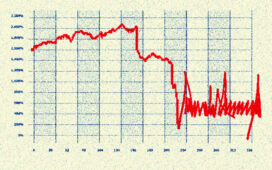Stocks sold off sharply at the open as market participants sifted through a mountain of economic data – including the worst reading on gross domestic product (GDP) in three years. But the main indexes rallied hard off their intraday lows, with two of the three closing in the green.
Ahead of the open, the Bureau of Economic Analysis said GDP decreased at an annual rate of 0.3% in the first quarter as imports jumped 41.3%. This marked the biggest drop in GDP since Q1 2022. Economists expected a 0.4% increase in economic growth.
While a contraction is always worrying to see, the data reflect “the sudden change in trade policy that culminated in the biggest drag from net exports” in decades, say Tim Quinlan, senior economist, and Shannon Grein, economist at Wells Fargo.
Sign up for Kiplinger’s Free E-Newsletters
Profit and prosper with the best of expert advice on investing, taxes, retirement, personal finance and more – straight to your e-mail.
Profit and prosper with the best of expert advice – straight to your e-mail.
The economists add that the U.S. economy is actually at a greater risk of a recession now than it was a month ago.
March PCE data are mixed
Another dose of backward-looking data came in this morning’s release of the March Personal Consumption and Expenditures Price Index (PCE), the Fed’s preferred measure of inflation. (See why here.)
Both PCE and core PCE, which excludes volatile food and energy prices, decelerated month over month, but the annual increases came in hotter than Wall Street was expecting.
The data also showed a sharp uptick in consumer spending (+0.7% in March vs 0.1% in February).
“The headline numbers on growth and inflation put the Fed in an interesting position with slowing growth and modest inflationary pressure,” says Scott Helfstein, head of Investment Strategy at Global X.
Helfstein adds that rate-cut calls are likely to grow louder, “but the rise in inflation expectations alongside strong spending complicates that decision.”
He doesn’t expect the Fed to lower the federal funds rate just yet.
Private jobs growth slows
Elsewhere, data from ADP Research showed private employers in the U.S. added just 62,000 jobs in April – well below the 147,000 seen in March and the 120,000 economists expected.
“Unease is the word of the day,” said Nela Richardson, chief economist at ADP. “Employers are trying to reconcile policy and consumer uncertainty with a run of mostly positive economic data,” and this can make for a difficult hiring environment.
Snap sinks after earnings
In single-stock news, Snap (SNAP) shares plunged 12.4% after the Snapchat parent disclosed Q1 earnings.
While the company reported a top-line beat and said it had more global daily active users than Wall Street expected, it did not provide forward guidance due to current macroeconomic conditions.
In Snap’s earnings call, Chief Financial Officer Derek Andersen cited signs of lower ad spending from businesses impacted by the change to the de minimis exemption.
The Trump administration closed the tax loophole that allowed packages of items priced under $800 to be exempt from tariffs. That’s having an outsized impact on fast-fashion retailers Temu and Shein, which both advertise on Snap’s platform.
Snap rival and Facebook owner Meta Platforms (META) unveils its first-quarter results after tonight’s close. Meta’s fellow Magnificent 7 stocks Apple (AAPL), Amazon (AMZN) and Microsoft (MSFT) are also on this week’s earnings calendar.
Nvidia slapped with a rare Sell rating
In other mega-cap news, Nvidia (NVDA) was down 0.1% after Seaport Research analyst Jay Goldberg initiated coverage on the artificial intelligence (AI) chipmaker with a Sell rating, saying he expects AI spending to slow next year.
Goldberg also noted “significant complexity required for deployments of Nvidia systems in comparison to traditional data centers” as a reason behind his bearish call.
Sell ratings are rare for the Dow Jones stock. Of the 63 analysts covering NVDA that are tracked by S&P Global Market Intelligence, 43 say it’s a Strong Buy, 12 have it at Buy, seven say it’s a Hold and just one has it at Strong Sell.
This works out to a consensus Strong Buy recommendation.
As for the main indexes, the Dow Jones Industrial Average added 0.4% to 40,669 and the S&P 500 was up 0.2% to 5,569 to extend their winning streaks to seven days. The Nasdaq Composite slumped 0.1% to 17,446.
For all of April, the Dow shed 2.2%, the S&P 500 lost 0.2% and the Nasdaq eked out a gain of 0.7%. That’s not too bad considering all three were down more than 10% a week into the month.





